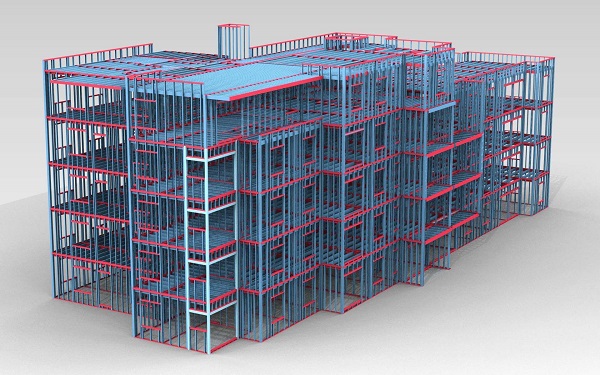In today’s rapidly evolving construction landscape, technological advancements are driving unprecedented innovation.
One standout area of progress is steel framing software, which is reshaping how construction projects are designed, planned, and executed.
From increased accuracy in design to improved project efficiency and reduced waste, steel framing software is revolutionizing modern construction practices.
1. Precision in Structural Design
Steel framing software tools such as Tekla Structures, Revit, and FrameCAD allow construction professionals to design steel frameworks with pinpoint accuracy.
Unlike traditional manual drafting, these digital tools utilize 3D modeling and Building Information Modeling (BIM) to ensure precision in every aspect of the structure—from load calculations to steel member dimensions and even connection details.
This accuracy reduces the risk of design errors, leading to fewer on-site modifications and delays. For instance, Tekla Structures enables the creation of highly detailed 3D models, including intricate steel connections, which help mitigate potential structural issues before they become costly problems on the construction site.
2. Enhanced Collaboration and Coordination
One of the biggest benefits of steel framing software is its ability to foster seamless collaboration between various stakeholders, including architects, engineers, and contractors.
Using BIM platforms, teams can work on a unified model, ensuring that everyone is on the same page. This collaboration is crucial for large-scale projects where coordination is key to avoiding costly delays.
For example, in multi-disciplinary projects, the steel framing model can be integrated with other systems like electrical or plumbing. Revit and Tekla allow for real-time updates, so when a change is made to the structural steel design, it is reflected across all related systems, minimizing the risk of clashes and rework.
3. Time and Cost Efficiency
Steel framing software plays a critical role in reducing both time and costs in construction projects. Tools like S-STEEL by S-FRAME Software offer advanced structural analysis, which helps optimize material use.
By performing detailed calculations and simulations, these tools ensure that the right amount of steel is used, avoiding over-engineering or under-specification. This leads to significant material savings and a more sustainable project outcome.
Moreover, software like FrameCAD automates many processes, including design and detailing, which cuts down on manual labor and speeds up the project timeline. The result is faster project completion and reduced costs associated with labor and materials.
4. Improved Sustainability
Sustainability has become a key consideration in modern construction. Steel framing software contributes to this by reducing waste and promoting the efficient use of materials. By creating highly accurate designs, these tools ensure that only the necessary amount of steel is used, minimizing offcuts and excess material.
Additionally, steel itself is a recyclable material, and steel framing software further supports sustainable construction practices by optimizing designs to use less material while maintaining structural integrity. This focus on sustainability appeals to clients and contractors who are looking to minimize their environmental impact.
5. Increased Safety and Compliance
Safety and regulatory compliance are top priorities in construction, and steel framing software helps ensure both. The software allows engineers to simulate various load conditions and environmental factors to test the integrity of steel structures. This analysis ensures that the structure will meet safety standards and can withstand potential stressors like wind, seismic activity, and heavy loads.
Furthermore, many steel framing tools are equipped with built-in compliance checks. RISA-3D, for example, integrates international building codes into its software, ensuring that designs meet local regulations. This feature reduces the risk of non-compliance, which could lead to legal issues and costly project delays.
6. Automation and Fabrication
Many steel framing software solutions are now bridging the gap between design and fabrication. Advanced software tools integrate with CNC (Computer Numerical Control) machines and other fabrication technologies, allowing designs to be directly translated into production instructions. This reduces the time between design and fabrication, eliminates manual errors, and speeds up the overall construction process.
Tools like Tekla PowerFab automate workflows from design through to production, providing real-time data on the status of steel fabrication, which enhances productivity and accuracy on-site.
7. The Future of Construction with Steel Framing Software
The adoption of steel framing software is only expected to grow as construction firms seek ways to enhance efficiency and reduce costs. As the industry moves toward more sustainable and modular construction methods, these tools will become even more essential in facilitating off-site fabrication and precise on-site assembly.
Moreover, advancements in artificial intelligence (AI) and machine learning are expected to further enhance the capabilities of steel framing software. These technologies could offer predictive analytics, helping designers and engineers optimize structural designs for future scenarios, such as climate change impacts or changing load requirements.
Conclusion
Steel framing software is not just a tool for improving construction efficiency—it is reshaping how the industry operates.
With benefits ranging from improved precision and collaboration to cost savings and sustainability, it’s clear that these software solutions are indispensable in modern construction.
As the industry continues to evolve, embracing the full potential of steel framing software will be key to staying competitive and ensuring long-term project success.
Also Read
How Augmented Reality (AR) is transforming the construction industry
How smart helmets and wearables are preventing injuries in the workplace

